The Trangia stove is a well-known and widely used camping and backpacking stove that has gained popularity among outdoor enthusiasts for its simplicity, durability, and compatibility with alcohol-based fuels.
If you’re new to using a Trangia stove for outdoor cooking, this blog post is here to help! In this step-by-step guide, we will walk you through using a Trangia stove, from selecting and preparing fuel to setting up the stove, igniting and adjusting the flame, cooking with it, and ensuring safety. My article on What is a Trangia stove will also give you a full walkthrough on what a Trangia stove is.
Whether you’re a beginner or have some experience with outdoor cooking, this guide will provide you with the necessary information to make the most of your Trangia stove and enjoy delicious meals in the great outdoors.
So, let’s dive in and learn how to use a Trangia stove for your next outdoor adventure!
How to use a Trangia Stove.
Using a Trangia stove is very straightforward once you learn how to use the equipment properly. I use a Trangia cookset that is hard-anodised which prevents scratching. I always recommend this trangia to all my friends and family who are interested in outdoor cooking. View my recommended Trangia Kit here.
Below I will go through the components of a Trangia stove and discuss how to put them together and how to ignite your stove for the first time. Set-up is pretty easy, and once you practice a couple of times, it becomes second nature.
Trangia Stove Components:
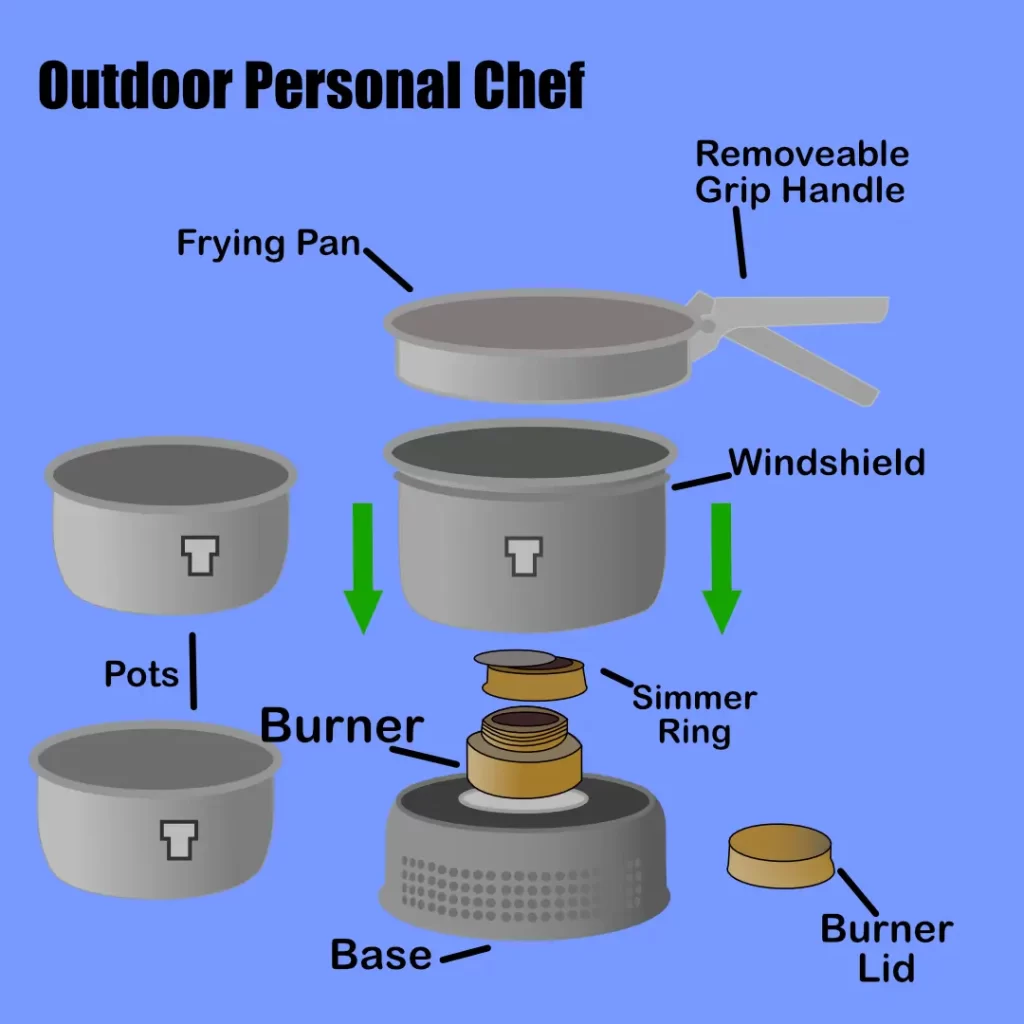
The Trangia stove has several main components that work together to create a functional cooking system. Understanding the purpose and function of each component is essential for using the Trangia stove effectively. Here’s a brief overview:
- Stove body: The stove body is the main structure of the Trangia stove, typically made of lightweight aluminium or stainless steel. It houses the burner and provides stability and support for the other components. It has air holes in its side to allow for correct air circulation.
- Burner: The burner is a small, compact alcohol-based stove that fits into the stove body. It has a wick or a burner ring that is soaked with alcohol fuel and is ignited to produce a controlled flame for cooking (a Trangia Gas Attachment can be purchased separately to use gas).
- Windscreen: The windscreen is a circular or cylindrical-shaped component that surrounds the burner and attaches to the stove body, serving as a barrier to protect the flame from wind and increase fuel efficiency.
- The pot supports: The pot supports are foldable metal arms that are attached to the windshield. These provide a platform for cooking cookware, such as pots or pans, on top of the Trangia stove.
- Cookware: Trangia stoves typically come with a set of cookware, including pots and pans specifically designed to fit the pot supports and work in conjunction with the burner for cooking various types of meals. Additional cookware such as a Trangia teapot and Trangia Multidisc, can be purchased. The Trangia Multidisc is a lid/chopping board and a base for extra support.
- Trangia Pot Handle: The Trangia pot handle is a remove vice-like handle that can be used to grip frying pans and pots that come with the Trangia cooking system. It is lightweight and packs away easily.
The stove body, burner, windscreen, pot supports, and cookware create a functional cooking system that is lightweight and portable.
Selecting and Preparing Fuel:
The Trangia stove is designed to be used with alcohol-based fuels, such as ethanol or methanol, which are widely available and commonly used for camping and backpacking. Here’s what you need to know about selecting and preparing fuel for your Trangia stove:
Types of alcohol-based fuels:
Ethanol and methanol are the most common alcohol-based fuels used with Trangia stoves. Ethanol is typically denatured alcohol, which is alcohol that has been rendered toxic or otherwise undrinkable to discourage consumption. Methanol, on the other hand, is a type of alcohol that is used as fuel and is readily available in hardware stores or camping supply shops.
Both types of alcohol-based fuels can be used with Trangia stoves. Still, checking the manufacturer’s instructions for the recommended fuel type for your specific Trangia model is essential. For more information on fuels for Trangia, read my article on which fuels are best for Trangia.
Selecting and purchasing fuel:
When selecting fuel for your Trangia stove, look for high-quality, pure alcohol-based fuels for camping stoves. Avoid using fuels with additives, as they can affect the performance and safety of the stove.
You can purchase suitable fuel from camping supply stores, hardware stores, or online. Following local regulations and guidelines for using and purchasing alcohol-based fuels in your area is important.
Preparing the fuel:
Properly preparing the fuel is essential for safely and efficiently using your Trangia stove. Start by measuring the fuel you need for your cooking, following the manufacturer’s instructions for your specific Trangia model. (Trangia normally recommends filling the fuel burner 3/4 full with approx ml of fuel)
Use a measuring cup or a graduated container to ensure accurate measurements. When pouring the fuel into the burner, do so carefully and slowly, avoiding spills or splashes. Do this in a well-ventilated area, away from open flames or heat sources, for added safety.
Always close the fuel container tightly after use and store it in a safe and well-ventilated place, away from children and pets. You can ensure safe and efficient cooking during your outdoor adventures by selecting and preparing the right fuel for your Trangia stove.
For safely transporting fuel, I recommend storing your fuel in a sealed container. Mark it red so you know it’s fuel. You can also purchase a Trangia fuel bottle which is perfect for this need. Following the manufacturer’s instructions and local regulations for using alcohol-based fuels is crucial for safely operating your Trangia stove.
Setting up the Trangia Stove:
Once you have selected and prepared your fuel, it’s time to set up your Trangia stove for outdoor cooking. Follow these step-by-step instructions to assemble and set up your Trangia stove properly:
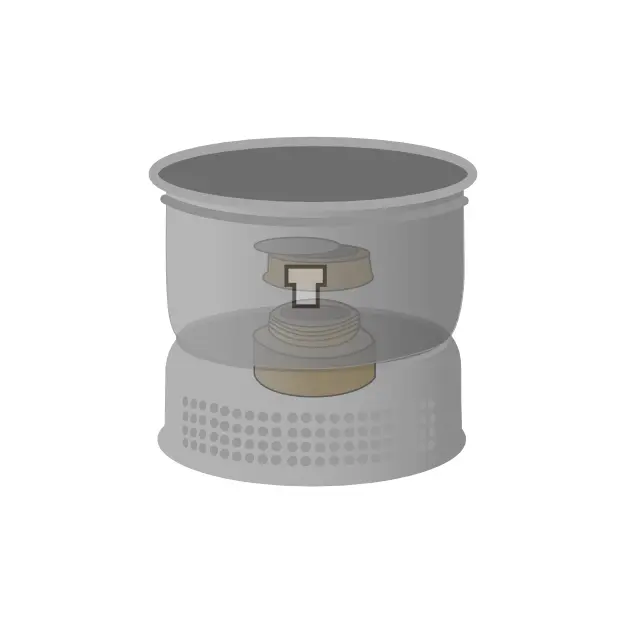
Assembling the stove body:
Start by removing all the components which have been bested together. Lay out all the components of your Trangia stove, including the stove body, burner, windscreen, and cookware.
Take the stove body and place it on a sturdy flat surface. To create a sturdy base, you can always attach the Trangia Multidisc to the base. This is great for placing it on snow or grass, which may be uneven.
Attaching the burner:
Next, attach the burner to the stove body. The burner is typically a separate component that fits into the designated opening on the stove body. Ensure the burner is properly seated and aligned with the opening to ensure a secure fit.
Installing the windscreen:
Screw the windscreen into the stove body, ensuring it fully encloses the burner. The windscreen protects the flame from wind and improves the stove’s efficiency by directing heat to the cookware.
Set the pot supports:
The pot supports are built into the windshield on top of the stove body. The pot supports are designed to hold your cookware in place during cooking. Adjust the pot supports as needed to fit the size of your cookware. The supports can be folded down for small pots, and for larger pans, fold them up.
Aligning and securing the components:
Double-check that all the components of your Trangia stove are properly aligned and secured. Ensure that the burner is centred in the stove body’s opening, the windscreen fully encloses the burner, and the pot supports securely hold the cookware. Proper alignment and securing of the components are essential for the safe and efficient operation of the Trangia stove.
By following these step-by-step instructions and properly aligning and securing the components, you can ensure your Trangia stove’s safe and efficient setup for outdoor cooking.
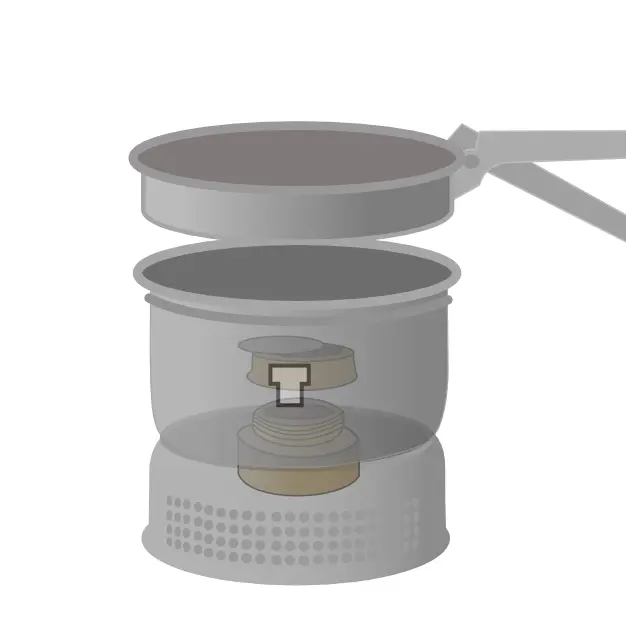
Igniting and Adjusting the Flame:
Once your Trangia stove is properly set up, it’s time to ignite the burner and adjust the flame for cooking. Follow these steps to ignite and adjust the flame on your Trangia stove safely:
Igniting the stove:
Unscrew the burner’s lid and carefully pour the prepared fuel into the burner, avoiding spills. Use a long match or lighter to ignite the fuel. Be sure to follow proper safety precautions, such as keeping your face and body away from the flame and avoiding loose clothing or other flammable materials. Once the fuel ignites, you should see a blue flame in the burner. If the weather is cold, the fuel may need to be heated before use. The best way is to roll some tissue paper and place it into the trangia burner into the fuel. Allowing it to act as a wick, the tissue will slow heat the fuel while providing an ignition source.
Adjusting the flame:
To adjust the flame, use the simmering ring or control valve on your Trangia stove if using gas. The simmering ring is a movable ring that can be placed over the burner to block the air intake and reduce the heat output partially. If available on your specific Trangia model, the control valve can adjust the fuel flow and control the flame intensity (this is if you have the Trangia Gas Burner Attachment)
To increase the flame, move the simmering ring away from the burner or open the control valve. To decrease the flame, move the simmering ring closer to the burner or close the control valve. Experiment with different settings to achieve the desired heat level for your cooking needs.
Managing the flame in different conditions:
Managing the flame on a Trangia stove may require adjustments depending on the weather conditions and altitude. The fuel may evaporate more slowly in cold temperatures, requiring adjustments to the simmering ring or control valve to maintain a consistent flame.
At higher altitudes, the reduced oxygen levels may affect fuel combustion, requiring air intake or fuel flow adjustments to maintain an optimal flame.
Safety precautions:
Always exercise caution when igniting and adjusting the flame on your Trangia stove. Keep a safe distance from the flame, avoid loose clothing or flammable materials, and never leave the stove unattended while it is lit.
Be familiar with your Trangia model’s specific safety features and instructions, and follow them carefully to ensure safe and responsible outdoor cooking.
Always prioritize safety and refer to your specific Trangia model’s instructions for any model-specific guidance or safety precautions.
Cooking with the Trangia Stove:
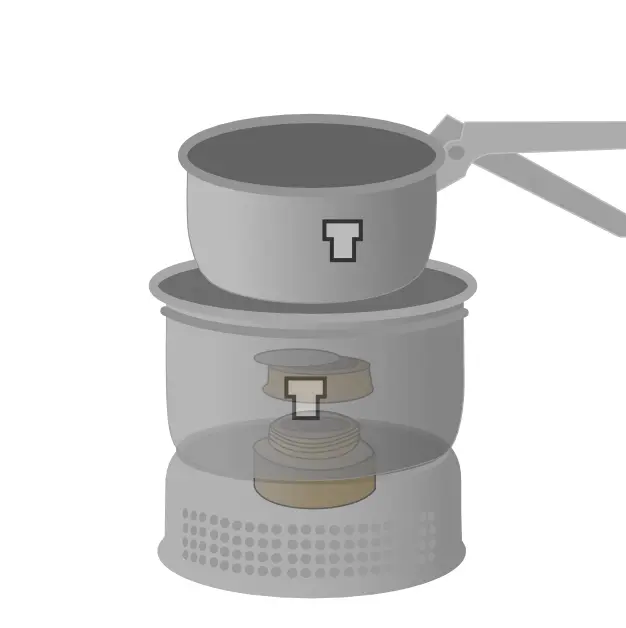
The Trangia stove is a versatile cooking system that can be used for various outdoor cooking tasks. Here are some tips and recommendations for cooking with your Trangia stove:
Recommended recipes:
The Trangia stove is well-suited for boiling water, simmering, and frying. Simple recipes like soups, stews, pasta, and rice dishes are ideal for Trangia stove cooking. You can also use it for frying foods like pancakes, eggs, or bacon.
Experiment with different recipes and techniques to find what works best for you.
Trangia tips:
To ensure successful cooking with your Trangia stove, use the pot supports to stabilize your cookware on the stove. Make sure the cookware is centred and stable to prevent spills or accidents.
Avoid overheating the cookware by adjusting the flame intensity and using the simmering ring or control valve to regulate the heat. Keep a close eye on cook times, as the Trangia stove can heat up quickly. Stirring and checking the food frequently can help prevent burning or uneven cooking.
Trangia Cleaning and maintenance:
After cooking, allow the Trangia stove to cool down before handling or cleaning. To clean the cookware and pot supports, use mild dish soap and water and gently scrub with a sponge or cloth. Avoid using abrasive materials that can scratch surfaces. Rinse thoroughly and dry the components before storing them.
Leave No Trace:
When using a Trangia stove for outdoor cooking, practising the Leave No Trace principles is important. Follow local regulations and guidelines for camping and cooking in wilderness areas. Always pack out any leftover food, food scraps, and packaging. Properly dispose of used fuel containers according to local regulations.
Leave your cooking area clean and free of any trash or debris.
By following these cooking tips and guidelines for cleaning and maintenance, you can enjoy successful outdoor cooking adventures with your Trangia stove while minimizing your environmental impact.
Safety Tips and Best Practices:
When using a Trangia stove for outdoor cooking, it’s crucial to prioritize safety. Here are some essential safety tips and best practices to keep in mind:
- Handle fuel safely: Alcohol-based fuels used in Trangia stoves are flammable and dangerous if not handled properly. Store fuel away from open flames, heat, and ignition sources in a designated bottle. Use caution when measuring and pouring fuel into the burner, and avoid overfilling. Always close and secure the fuel bottle when not in use.
- Operate in a well-ventilated area: Trangia stoves should be operated in a well-ventilated area to prevent the build-up of fumes. Avoid using the stove in enclosed spaces or tents, which can lead to carbon monoxide poisoning. Set up the stove in a well-ventilated area with good airflow, and ensure adequate space between the stove and any flammable materials.
- Practice responsible cooking: Follow best practices for responsible cooking with a Trangia stove. Set the stove on a stable surface away from flammable materials, and use the pot supports to stabilize cookware. Adjust the flame carefully to avoid overheating and spills. Always monitor the stove while cooking and be cautious when handling hot cookware and stove components.
- Educate yourself and others: Familiarize yourself with the manufacturer’s operating instructions and safety guidelines for your specific Trangia stove model. Share your knowledge with others in your camping group, and ensure everyone understands how to operate the stove safely.
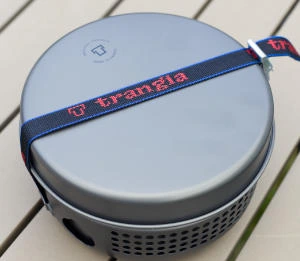
Conclusion:
In conclusion, using a Trangia stove for outdoor cooking can be a rewarding and enjoyable experience. We’ve covered the main components of a Trangia stove, including the stove body, burner, windscreen, pot supports, and cookware.
We’ve discussed selecting and preparing fuel, setting up the stove, igniting and adjusting the flame, cooking with the stove, and important safety tips and best practices.
With its simplicity, durability, and compatibility with alcohol-based fuels, the Trangia stove is a popular choice for outdoor cooking enthusiasts.
Following the step-by-step guide and safety guidelines in this blog post, you can safely and effectively use a Trangia stove for your camping or backpacking adventures.
If you want to explore Trangia stoves further, check out their official website for recommended accessories and additional information. You can also find plenty of resources and articles on outdoor cooking and camping to enhance your skills and knowledge.
Happy outdoor cooking with your Trangia stove!
Stay safe and enjoy the delicious meals you can create outdoors.
Outdoor Personal Chef is a participant in the Amazon Services LLC Associates Program, an affiliate advertising program designed to provide a means for sites to earn advertising fees by advertising and linking to Amazon.com. We also participate in other affiliate programs which compensate us for referring traffic.
